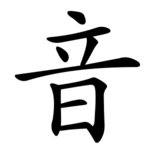| 音 | ||
|---|---|---|
| ||
| 音 (U+97F3) "sound" | ||
| Pronunciations | ||
| Pinyin: | yīn | |
| Bopomofo: | ㄧㄣ | |
| Wade–Giles: | yin1 | |
| Cantonese Yale: | yam1 | |
| Jyutping: | jam1 | |
| Japanese Kana: | オン on / イン in (on'yomi) おと oto / ね ne (kun'yomi) | |
| Sino-Korean: | 음 eum | |
| Hán-Việt: | âm, ậm, ơm | |
| Names | ||
| Japanese name(s): | 音/おと oto 音偏/おとへん otohen | |
| Hangul: | 소리 sori | |
| Stroke order animation | ||
 | ||
Radical 180 or radical sound (音部) meaning "sound" is one of the 11 Kangxi radicals (214 radicals in total) composed of 9 strokes.
In the Kangxi Dictionary, there are 43 characters (out of 49,030) to be found under this radical.
音 is also the 186th indexing component in the Table of Indexing Chinese Character Components predominantly adopted by Simplified Chinese dictionaries published in mainland China.
YouTube Encyclopedic
-
1/5Views:24 8834 640 8241 2338 160 6581 297
-
Juan Carlos Formell y Son Radical perform Control Control
-
The mad scientist of music | Mark Applebaum
-
Geometry Regents June 2009 Solutions
-
Tchaikovsky – Swan Lake
-
Other Spaces (United Visual Artists) - The Store X The Vinyl Factory
Transcription
Evolution
-
Bronze script character
-
Large seal script character
-
Small seal script character
Derived characters
| Strokes | Characters |
|---|---|
| +0 | 音 |
| +2 | 竟 章 |
| +4 | 韴 韵SC (=韻) |
| +5 | 韶 韷 |
| +7 | 韸 |
| +8 | 韺SC |
| +9 | 韹 韺TC |
| +10 | 韻 韼SC |
| +11 | 韼TC韽 韾 響JP/響GB TC |
| +12 | 響TC |
| +13 | 頀SC |
| +14 | 頀TC |
Sinogram
The radical is also used as an independent Chinese character. It is one of the Kyōiku kanji or Kanji taught in elementary school in Japan.[1] It is a first grade kanji[1]
References
- ^ a b "The Kyoiku Kanji (教育漢字) - Kanshudo". www.kanshudo.com. Archived from the original on March 24, 2022. Retrieved 2023-05-06.
Literature
- Fazzioli, Edoardo (1987). Chinese calligraphy : from pictograph to ideogram : the history of 214 essential Chinese/Japanese characters. calligraphy by Rebecca Hon Ko. New York: Abbeville Press. ISBN 0-89659-774-1.



